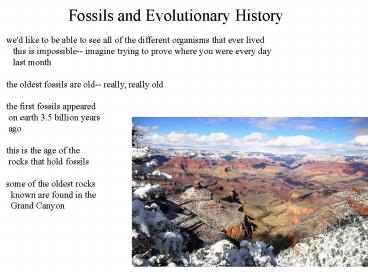Fossils and Evolutionary History - PowerPoint PPT Presentation
1 / 13
Title:
Fossils and Evolutionary History
Description:
cladistics: study of evolutionary relationships based on an organism and. its descendents ... cladistics looks over time; phylogenetic tree looks at current organisms ... – PowerPoint PPT presentation
Number of Views:23
Avg rating:3.0/5.0
Title: Fossils and Evolutionary History
1
Fossils and Evolutionary History
we'd like to be able to see all of the different
organisms that ever lived this is impossible--
imagine trying to prove where you were every day
last month the oldest fossils are old--
really, really old the first fossils appeared
on earth 3.5 billion years ago this is the age
of the rocks that hold fossils some of the
oldest rocks known are found in the Grand
Canyon
2
Fossils and Evolutionary History
geologic time the huge number of years in which
the Earth has existed radioactive dating using
radioactive decay (that happens at a constant
rate) to determine the age of a substance some
radioactive elements decay quickly 35S 90 days
others aren't quite so short
13C 5760 years 40K1.3 billion
years use different isotopes to measure
different ages used for human bones, tools,
almost anything old
3
Fossils and Evolutionary History
just like organisms have changed over time, the
Earth itself has changed continental drift
theory that large pieces of crust, or plates,
float on a layer of molten rock and that move
over millions of years plates move slowly 1.5
inches per year where plates separate,
volcanoes form where plates come together,
mountains are forced up where they touch,
earthquakes occur
4
Fossils and Evolutionary History
fossils that used to be found together are now
located thousands of miles apart-- when the
organisms died, they were close together works
for living organisms too-- lungfishes, old and
new world monkeys are found on several
continents now, but those continents used to be
together millions of years ago Pangea
'supercontinent' when all of the continental
plates were joined together before
separating drifted apart over millions of
years-- why there are old and new world monkeys
5
Fossils and Evolutionary History
volcanoes and earthquakes occur most frequently
along fault lines where plates join these can
be more than locally destructive Krakatau was a
volcano that spit out so much dust and ash that
GLOBAL temperatures dropped 2 degrees for
several years other cataclysms have caused
global changes as well about 65 million years
ago, a large meteor hit the earth in the Gulf
of Mexico-- believed to have killed off the
dinosaurs (and many others) Iridium (a rare
earth metal often in meteorites) is found in 1
layer of clay and rock at this age
6
Fossils and Evolutionary History
mass extinction time when many species are wiped
out within a 'short' period of time (geologic
time!) these have occurred several times in
history about 1 billion years ago--
eukaryotes and multicellular organisms
became dominant 600 million years ago-- 95 of
all species killed off! about 65 million years
ago-- mammals became dominant currently--
there is evidence that human activity is
killing off species fast enough to be called a
mass extinction (over geologic time) after
previous mass extinctions, new organisms
proliferated
7
Fossils and Evolutionary History
8
Fossils and Evolutionary History
sometimes certain structures get repeated or
reused over time phylogeny evolutionary history
of an organism-- where did it come from
measured using anatomical and sometimes molecular
evidence homologous structure structures that
may function differently but have important
similarities suggesting a common ancestor fly
eyes and human eyes look very different
molecularly, some key molecules are similar
enough to replace each other's functions! analago
us structure structure that looks alike but come
from different sources-- process known as
convergent evolution same types of adaptations
to similar environments
9
Fossils and Evolutionary History
systematics analytical approach to understanding
the relationships between other organisms both
living and dead relies on a hierarchy to group
similar organisms we've already seen domains
and kingdoms phylogenetic tree way of
displaying the relationships between different
organisms and the degree of relationship
10
Tree of Life
represents how closely different organisms are
related many organisms are very different than
other relatives insects are not very related to
vertebrates plants are even less related to
vertebrates more closely related organisms
branch off near each other
11
Fossils and Evolutionary History
cladistics study of evolutionary relationships
based on an organism and its descendents
based on the development of inherited
characteristics cladistics looks over time
phylogenetic tree looks at current
organisms ingroup closely related
organisms outgroup nearest related organism
that lacks a defining characteristic outgroups
provide a reference point parsimony simplest
relationship is probably correct similar
characteristics probably evolved only once
12
Fossils and Evolutionary History
systematics (and all of science, for that matter)
are the most likely hypothesis based on
available evidence new experiments, fossils, or
techniques can change older classifications DNA
sequencing is changing some (but confirming
most!) relationships As of March, 2006 over 100
billion DNA bases have been sequenced DNA can
confirm both very very distant and very close
relationships mutations occur at roughly a
constant rate-- more differences early
divergence
13
Fossils and Evolutionary History
DNA sequencing has been completed for a number of
species humans and chimpanzees have 99
identical DNA-- very very high even very
distantly related organisms have some similarity
in many of their genes-- many life functions
are the same 25 of human genes have similar
bacterial genes 50 of human genes have similar
yeast genes as more DNA is sequenced, accuracy
of relationships are improved































